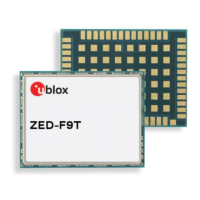ZED-F9T-Integration Manual
3 Receiver functionality
This section describes the ZED-F9T operational features and their configuration.
3.1 Receiver configuration
The ZED-F9T is fully configurable with UBX configuration interface keys. The configuration
database in the receiver's RAM holds the current configuration, which is used by the receiver
at run-time. It is constructed on start-up of the receiver from several sources of configuration.
The configuration interface and the available keys are described fully in the ZED-F9T Interface
Description [2].
A configuration setting stored in RAM remains effective until power-down or reset. If stored in
BBR (battery backed RAM), the setting will be used as long as the backup battery supply remains.
Configuration settings can be saved permanently in flash memory.
The configuration interface has changed from earlier u-blox positioning receivers.
There is some backwards compatibility however, users are strongly advised to adopt the
configuration interface described in this document. See legacy UBX-CFG message fields
reference section in the ZED-F9T Interface Description [2].
Configuration interface settings are held in a database consisting of separate configuration
items. An item is made up of a key ID and value pair. Related items are grouped together and
identified under a common group name: CFG-GROUP-ITEM; a convention used in u-center and
within this document. Within u-center, a configuration group is identified as "Group name" and the
configuration item is identified as the "item name" under the "Generation 9 Configuration View" -
"Advanced Configuration" view.
The UBX messages available to change or poll the configurations are the UBX-CFG-VALSET, UBX-
CFG-VALGET, and UBX-CFG-VALDEL messages. For more information about these messages and
the configuration keys see the configuration interface section in the ZED-F9T Interface Description
[2].
3.1.1 Changing the receiver configuration
All configuration messages, including legacy UBX-CFG messages, will result in a UBX-ACK-ACK
or UBX-ACK-NAK response. If several configuration messages are sent without waiting for this
response then the receiver may pause processing of input messages until processing of a previous
configuration message has been completed. When this happens a warning message "wait for cfg
ACK" will be sent to the host.
3.1.2 Default GNSS configuration
The ZED-F9T default GNSS configuration is set as follows:
• GPS: L1C/A, L2C
• GLONASS: L1OF, L2OF
• Galileo: E1B/C, E5b
• BeiDou: B1I, B2I
• QZSS: L1C/A, L2C
SBAS is also supported but not enabled in the default GNSS configuration. SBAS is not
recommended for timing applications.
For more information about default configuration, see the ZED-F9T Interface Description [2].
UBX-19005590 - R01
3 Receiver functionality Page 9 of 80
Advance Information

